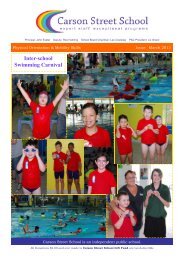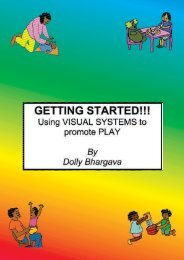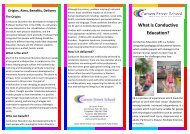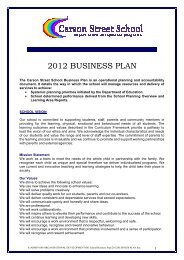Getting Started: Using Visual Systems to Promote Communication
Getting Started: Using Visual Systems to Promote Communication
Getting Started: Using Visual Systems to Promote Communication
You also want an ePaper? Increase the reach of your titles
YUMPU automatically turns print PDFs into web optimized ePapers that Google loves.
11<br />
Topic 5 - Why use visual systems?<br />
<strong>Visual</strong> systems can be particularly helpful for children with the following difficulties:<br />
a) <strong>Communication</strong> difficulties - In order for communication <strong>to</strong> take place, the<br />
child needs <strong>to</strong> understand what is being communicated <strong>to</strong> them and be able <strong>to</strong><br />
convey their messages. It can be very frustrating for children who have<br />
difficulties with understanding and/or expressing themselves. This frustration<br />
can often lead <strong>to</strong> the child resorting <strong>to</strong> using inappropriate behaviours <strong>to</strong> get<br />
their message across. <strong>Visual</strong> systems can make communication more<br />
accessible.<br />
b) Slow information processing - Slow information processing means that the<br />
way the brain is processing communication is affected. As a consequence<br />
the child requires more time <strong>to</strong> "take in" the information process (interpret)<br />
information respond <strong>to</strong> the information. The child may require multiple<br />
opportunities <strong>to</strong> practice and remember the information. Without the<br />
additional time the information may come and go <strong>to</strong>o quickly without the child<br />
understanding or responding appropriately.<br />
<strong>Visual</strong> systems are permanent and non-transi<strong>to</strong>ry whereas language is<br />
fleeting. In other words when we present information verbally, the words are<br />
available for a brief moment and if the child did not hear the verbal information<br />
then they have missed out. Whereas when the information is presented<br />
visually it is static and it can be there for as long as the child needs.<br />
c) Attention difficulties - Effective communication requires the ability <strong>to</strong> rapidly<br />
establish attention on what is being said, maintain attention and shift attention<br />
<strong>to</strong> the next <strong>to</strong>pic. However, many children with attention difficulties<br />
experience difficulty establishing, maintaining and shifting attention at the<br />
speed necessary <strong>to</strong> participate effectively in communication interactions. As a<br />
consequence the verbal information may disappear before the child has had a<br />
chance <strong>to</strong> pay attention enough <strong>to</strong> take in what is being said. They may miss<br />
a lot of information and only receive fragments of the verbal information.









